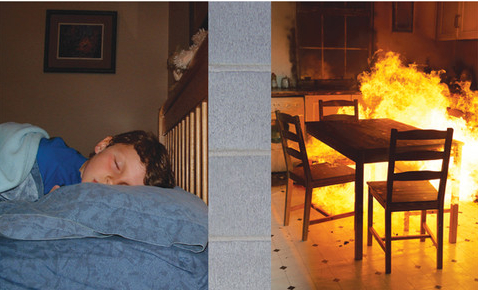Building Safe Communities THAT LAST
“You may check your smoke alarms every six months, but does your neighbour check his?”
Carl Pearson, Immediate Past-President of Fire Fighter Association of Ontario
Fire Resistance is a big part of what makes a community safe. As civic leaders plan for the future, occupant safety should come first, and meeting safety needs through design is a critical component.
Masonry products provide superior fire resistance and superior fire performance to protect homeowners and the neighbourhoods where they live, work and play.
Masonry does not burn
Masonry does not burn, unlike wood, vinyl siding and EIFS (stucco) products. As a result, masonry minimizes the risk of fire spreading from within, and to/from neighbouring buildings. 1
Firewalls required to be masonry:
The Ontario Building Code requires two-hour (and less) firewalls to be constructed only of masonry and concrete: where they separate buildings; in buildings with floor areas that include care or detention facilities; and in buildings higher than 4-storey. And all non-masonry or concrete firewalls must equal the performance of masonry or concrete during fire conditions.
Masonry maintains structural integrity.
Masonry maintains structural integrity under fire load for a much longer period than alternative materials having the same fire-resistance rating. A masonry wall will continue to carry loads, long after its established fire-resistance rating period has been reached. 2
In a fire, masonry does not produce toxic smoke.
In a fire, masonry does not produce toxic smoke, gases, or vapours. 80% of fire deaths result from the inhalation of smoke, gases and vapours rather than from heat or direct contact with the flames.
The inherent strength of masonry resists damage
The inherent strength of masonry resists damage from high-pressure water streams used by firefighters and impacts from collapsing debris and explosion that otherwise would permit fire to readily pass. 3
Masonry contributes to discounted insurance.
Masonry materials may contribute to discounted insurance premiums, according to the Insurance Bureau of Canada, and the Fire Fighters Association of Ontario warns, “owners of higher combustible buildings will likely face higher insurance costs.”

A Masonry Community is a Safer Community
Within 3 minutes a house can be completely over-run by fire, 5 causing considerable hazard to human health and safety, and danger to pets and prized possessions. Masonry firewalls are designed to withstand prolonged fire exposure so that fire will not spread from one building to the next. 6 “Fire-spread between adjacent buildings can be controlled through adequate spatial separation between buildings, and/or the use of fire-resistant barriers called firewalls,” says Forintek Canada Corporation and CMHC. 7 With lot sizes shrinking and spaces between houses narrowing, communities are more vulnerable than ever to the spread of fire.
A Balanced Design Approach to Fire Safety
To better prepare homes and businesses in the event of a fire, MasonryWorx, CCMPA and other industry experts have outlined the components of a ‘balanced-design approach’ to building construction that will help prevent the spread of fire:
- A detection system: Warning systems such as smoke detectors warn occupants when a smoke or a fire has been detected and alert the fire department.
- An automatic suppression system: Sprinklers in completed buildings will warn occupants of a fire, and put out many fires before they do much damage to the structure.
- A containment system: Fire containment includes: fire barriers, firewalls, exterior walls, floors and roofs of noncombustible fire resistant materials such as concrete and masonry.
- Compartmentalization: This method of construction divides the structure into smaller areas in high-hazard zones to control a fire until it can be extinguished. It prevents the fire from spreading outside of the structure and, with the right material, will add no additional toxic fumes to the smoke. It is fundamentally important for the compartmentalization to be constructed with noncombustible material, such as masonry.
This balanced approach to fire prevention and safety provides a redundancy so that all elements work together to protect the building from fire damage. The combination of detection, suppression, compartmentalization and containment, along with education and fire drills, give occupants the best possible chance of escaping, while also potentially lowering the overall fire damage.
Fire Resistance is a big part of what makes a community safe. As civic leaders plan for the future, occupant safety should come first, and meeting safety needs through design is a critical component.
Masonry products provide superior fire resistance and superior fire performance to protect homeowners and the neighbourhoods where they live, work and play.
